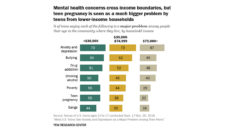In the U.S., one in eight high school students experiences physical and/or sexual violence by someone they are dating each year. These experiences of dating violence can have negative consequences for the rest of these young people’s lives, including depression, anxiety suicidal ideation, increased substance use, disordered eating, intimate partner violence, and, in extreme cases, death. This substantial public health problem has gained increasing awareness and attention. Since 2010, February has been officially recognized as National Teen Dating Violence Awareness and Prevention Month.
Teen dating violence is preventable, and schools are one important setting for programs that help students navigate romantic relationships. Partly as a result of advocacy following murders of girls and young women by their intimate partners, several states have enacted legislation requiring schools to address dating violence. These laws are broad, policy-level interventions—similar to now-widespread anti-bullying laws—that lay the foundation for a range of activities in schools, including education for student and training for school staff.
To better understand the content and variability of these laws, our research team conducted a detailed analysis of state laws addressing the prevention of and response to teen dating violence in secondary schools. We examined laws in the 50 U.S. states and the District of Columbia.
Laws are constantly evolving, providing ample opportunities for improving the comprehensiveness of school-based teen dating violence interventions.
As of September 2020, 38 states (75%) had at least one law related to teen dating violence in schools. However, we found substantial variability in what was included in the laws. For example, only 15 states even defined teen dating violence. And only 9 addressed cyber dating violence despite how common technology-enabled abuse is among teens. All 38 states either required or encouraged prevention education, which mostly included teaching about healthy relationships. This education was primarily directed at students, with far fewer requirements for training for school staff or parents. Importantly, only one-third of states noted that prevention education had to be evidence-based, providing states and schools wide latitude regarding what to teach.
There was also variation in teen dating violence policy requirements and responses. About half of states required or encouraged school districts to develop a written policy. Only 4 states required an investigation once violence was reported or required districts to develop a policy regarding investigations. Although the negative mental health consequences of teen dating violence are well-established, only 3 states specified providing mental health services for affected students.
These laws require resources – such as staff time and funding – to implement. However, the majority of states did not designate an individual to coordinate anti-dating violence efforts or include funding. Notably, most states did not include explicit consequences for noncompliance with the law.
While it is heartening to see state legislatures recognizing and responding to teen dating violence, these laws have significant gaps. Funding to schools to implement these programs is critical as is assigning accountability to a specified individual or group.
Laws are constantly evolving, providing ample opportunities for improving the comprehensiveness of school-based teen dating violence interventions. State laws offer an opportunity to raise awareness, alter the social context of schools, and funnel resources into preventing and responding to dating violence to ultimately support adolescent safety and well-being.
Photo via Getty Images














